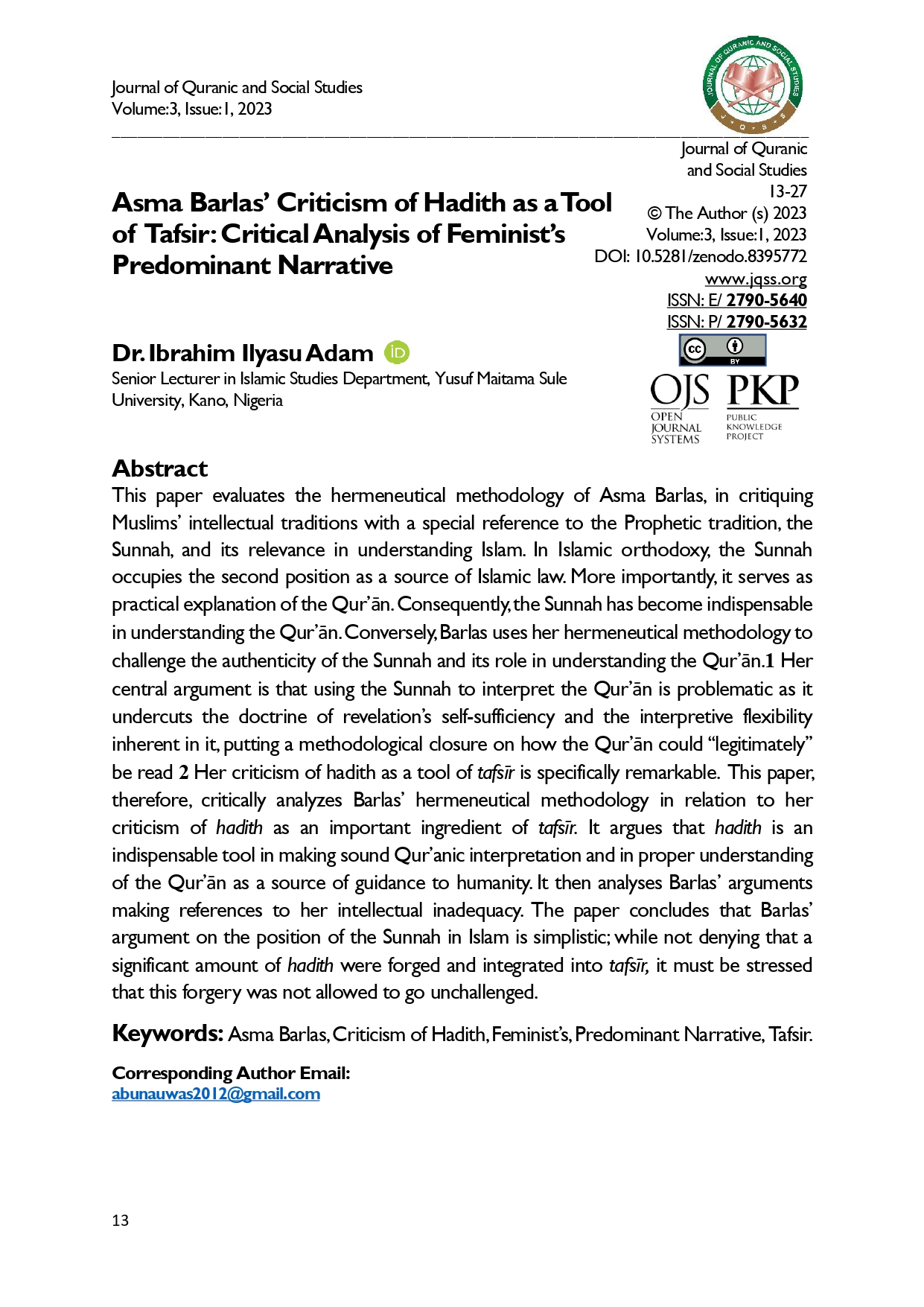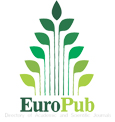Asma Barlas’ Criticism of Hadith as a Tool of Tafsir: Critical Analysis of Feminist’s Predominant Narrative
DOI:
https://doi.org/10.5281/zenodo.8395772Keywords:
Asma Barlas, Criticism of Hadith, Feminist’s, Predominant Narrative, Tafsir.Abstract
This paper evaluates the hermeneutical methodology of Asma Barlas, in critiquing Muslims’ intellectual traditions with a special reference to the Prophetic tradition, the Sunnah, and its relevance in understanding Islam. In Islamic orthodoxy, the Sunnah occupies the second position as a source of Islamic law. More importantly, it serves as practical explanation of the Qur’ān. Consequently, the Sunnah has become indispensable in understanding the Qur’ān. Conversely, Barlas uses her hermeneutical methodology to challenge the authenticity of the Sunnah and its role in understanding the Qur’ān.1 Her central argument is that using the Sunnah to interpret the Qur’ān is problematic as it undercuts the doctrine of revelation’s self-sufficiency and the interpretive flexibility inherent in it, putting a methodological closure on how the Qur’ān could ‘‘legitimately’’ be read 2 Her criticism of hadith as a tool of tafsīr is specifically remarkable. This paper, therefore, critically analyzes Barlas’ hermeneutical methodology in relation to her criticism of hadith as an important ingredient of tafsīr. It argues that hadith is an indispensable tool in making sound Qur’anic interpretation and in proper understanding of the Qur’ān as a source of guidance to humanity. It then analyses Barlas’ arguments making references to her intellectual inadequacy. The paper concludes that Barlas’ argument on the position of the Sunnah in Islam is simplistic; while not denying that a significant amount of hadith were forged and integrated into tafsīr, it must be stressed that this forgery was not allowed to go unchallenged
References
Barlas, Asma. (2002). “Believing Women” in Islam: Unreading Patriarchal Interpretations of the Quran. Austin: University of Texas Press.
Ibid :33
Ibid
Ibid: 33
Ibid:42
‘Asma Barlas’ (2007). Bio/CV [online] http://www.asmabarlas.com/cv.html (updated 21 April 2007, accessed 10 April 2011)
Barlas, Asma. (2002). “Believing Women” in Islam: Unreading Patriarchal Interpretations of the Quran. Austin: University of Texas Press.
Ibid: 33
Ibid:42
Ibid :32
Ibid: 66
Ibid:67
Ibid: 64
Ibid: 64-65
Ibid: 38
Ibid:42
Ibid: 65
Ibid
Ibid: 98
Al Nahl: 44
Ibn Kathir, Imaduddin Abul Fidl, Ismai’l bin Kathir al-Qurashi. (1968). Tafsir al-Qur’an al-azim.. Dar Ihya’ al-Turath al-Arabi, Beirut. Lebanon. 4 :85
Al-Nisa: 80
Al-Nisa: 59
Abu Hayyan, Muhammad bin Yusuf. (2001). Tafsir al-Bahr al-Muhit. Dar al-Kutub al-‘Ilmiyyah, 2:291
Ibid
Al-Nisa: 60
Ibn ‘Ashur, Muhammad al-Tahir. (2001). Tafsir al-Tahrir wa al-Tanwir. Beirut: Lebanon., Muasssat al-Tarikh, 1: 169-170
Al-Nisa: 51
Al-Nisa: 64
Ibn Hajar, Ahmad bin Aliy al-Asqalani. (1986). Fath al-Bari, Sharh al-Sahih al-Bukhari, Dar al-Rayyan li al-Turath. Lebanon, 2:114-115
Al-Nur: 54
Ibn Kathir, Imaduddin Abul Fida, Ismai’l bin Kathir al-Qurashi, Tafsir al-Qur’an al-azim: 322
Al -Nisa: 115
Ibn Kathir, Imaduddin Abul Fida, Ismai’l bin Kathir al-Qurashi, Tafsir al-Qur’an al-azim:277
Ibn ‘Ashur, Muhammad al-Tahir, Tafsir al-Tahrir wa al-Tanwir, 4: 255
Ibn Taymiyyah, Ahmad Ibn Abdul halim. (1970). Raful al-Malam an al-A’immah al-Alam. Beirut: al-Maktab al-Islami, 1:11
Ibn Rushd, Muhammad Ibn Ahmad.(2002 ). Bidayat al-Mujtahid wa Nihayat al-Muqtasid. Dar al-Kutub al-Ilmiyyah. Beirut: Lebanon,1:225
Ibn Abi Hatim, Abd al-Rahman Ibn Muhammad. (1952). al-Jarh wa al-Taadil. Hyderabad, India: Majlis Da’irah al-Ma‘arif al-Uthmaniyyah, 4:445
al-Sibai’, Mustapha, (1998). al-Sunnah wa Makanatuha fi al-Tashri al-Islami, (The Sunnah and its Role in Islamic Legislation). Trans by Faisal Ibn Muhammad Shafi’. International Islamic Publishing House: 254
Ibid: 259
Hoffman, Moradd. (2007). Islam and the Quran. Ist ed. Amana Publications: 57

Downloads
Published
How to Cite
Issue
Section
License
Copyright (c) 2023 Journal of Quranic and Social Studies

This work is licensed under a Creative Commons Attribution 4.0 International License.



























